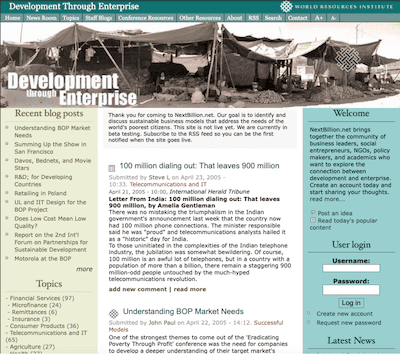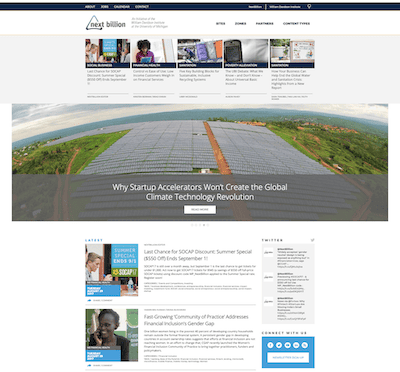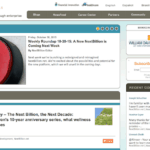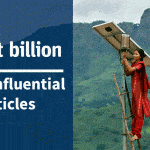Looking Back, Looking Forward: Exploring NextBillion’s New Features and Updated Design, As We Approach Our Third Decade Online
Yesterday, NextBillion launched the latest phase of our ongoing site redesign. You likely noticed some of these changes already, as we’ve been rolling them out gradually over the past year — and we will make some additional (smaller) updates in the coming months.
Since this redesign represents one of the most significant shifts of the site’s features and functionality in our almost 20-year history, we wanted to explain the thinking behind these changes, and explore how our new design reflects both NextBillion’s ongoing evolution, and the evolution of the broader “impact media” space.
But first, a quick trip down memory lane.

If you were among our original readers, you may recall that this is how NextBillion looked in 2005, shortly after it was launched by the World Resources Institute (WRI), its original parent organization. The site’s initial goal was to provide a forum to continue conversations from WRI’s “Eradicating Poverty Through Profit: Making Business Work for the Poor” conference, held in December of 2004.
In those days — the heyday of the “blogosphere” — the site’s design and publishing process were typical of the countless independent blogs that populated the internet. The homepage featured lots of text but few images, and the content was freely uploaded by a community of guest posters, who came to share and discuss topics related to emerging markets business and social entrepreneurship — particularly the base of the pyramid space.
These blog posts were generally short, and were not edited or fact checked — but they typically inspired plenty of reader comments. There were few comparable platforms for this sort of discussion in those years: The impact media space was still in its infancy, limited to NextBillion and a handful of other pioneering publications like Triple Pundit, Business Fights Poverty and the Stanford Social Innovation Review, which had also launched around that time. And social media hadn’t yet taken over the internet: Facebook was still only available to university students, and Twitter wouldn’t debut until 2006.

Here’s how the site looked in 2010, the year the William Davidson Institute (WDI) joined the World Resources Institute as its co-manager.
Under the leadership of co-managing editors Francisco Noguera and Scott Anderson (who now leads WDI’s communications team), NextBillion was beginning to move toward its current iteration. Its content still included guest-written blog posts, but its articles were becoming longer and more formal. Instead of short posts uploaded by readers, the site’s editors had begun sourcing and reviewing submitted posts, and contributing regular articles of their own.
NextBillion had also begun to feature more aggregated content, publishing cross-posts from the growing community of websites covering social and emerging markets business — and highlighting more external coverage on its newsfeed, which featured excerpts and links to other publishers’ articles on these topics.
By this time, NextBillion had started enabling readers to submit job opportunities for publication on the site — a feature that remains one of our most popular services.

By the time I came onboard in 2012, as editor of the short-lived NextBillion Health Care blog (and later the much more successful Financial Innovation blog), the site’s core features and publishing model were in place. This iteration of NextBillion included the addition of a calendar, to keep tabs on the growing number of events in the sectors we cover.
With WDI as our sole parent organization and Scott Anderson as sole managing editor, the site maintained a fast-paced publication schedule of two (or more) daily articles, including both originals and cross-posts. But the active commenting culture that had initially defined the platform was diminishing, moving from several comments per post, to a handful of comments site-wide per week.
We tried to entice people to engage, by highlighting recent comments on the homepage — and sometimes by playing up our more provocative articles. But we gradually recognized that these discussions had become dispersed across social media and larger publications and platforms — or overwhelmed by spam. Substantive conversation and close-knit commenter communities were becoming harder to find across the blogosphere: It was time to look forward, not back.

By 2017, when I took over as the site’s editor, NextBillion had shifted to a far more photo-centric, magazine-like design. Our articles were also changing, becoming progressively longer as guest writers submitted more detailed explorations of the challenges and opportunities of emerging markets business. By this point, the site’s original focus on the base of the pyramid had broadened: Emerging economies were developing, businesses were seeking new opportunities up market, and the concept of social business had entered the mainstream: Our content still had a strong focus on business models that served the poor, but our guest articles increasingly explored other pathways to impact.
Articles had also become less frequent: Instead of publishing two pieces per day, with regular cross-posts from other sites, we had begun publishing a smaller number of exclusively original articles. Around this time, we discontinued our commenting functionality, shifting our focus from fostering reader discussion and debate, to building a knowledge resource composed of original content that was thoroughly sourced and edited, and aggregated content that chronicled the broader trends and developments in our sectors of coverage.
As the impact media space had evolved to include a number of specialized publications with their own growing audiences — and emerging markets businesses themselves were drawing increasing mainstream media coverage — we began to focus more of our news aggregation efforts on local and national publications within the Global South.
Today, our original content inhabits the space between informal blogs and academic articles — rigorous and detailed yet accessible — with two or three original articles, typically ranging from 1,000 to 1,500 words, published each week. Our newsfeed has become one of the site’s most-visited pages, and our events calendar and jobs board continue to draw considerable traffic and reader submissions.
Now, as we launch the latest iteration of NextBillion, we’ve tried to create a design that leverages the site’s position as a pioneer in the coverage of emerging markets business and social enterprise, while streamlining and expanding our open publishing model. The key elements of the new design include:
- A new service for our core audience: Entrepreneurs in emerging markets have always been at the center of our mission. To further support their vital work, we’ve launched a new feature: Our Business Development (BizDev) page. The page will feature accelerators, competitions, funding opportunities, incubators, requests for proposals and training courses focused on (or available to) enterprises working in low- and middle-income countries. Some of these will be independently sourced by NextBillion — but we also invite readers to submit items of their own for consideration. (Like all our coverage and services, these ads are free of charge.)
- Easier filtering by sector and topic: With almost 20 years of content, over 6,000 (mostly original) articles and over 19,000 aggregated news items on the site, we see NextBillion as an invaluable knowledge resource — a place where many of the top thought leaders in our sectors of coverage have published (and continue to publish) their insights, and where the rise (and sometimes the fall) of countless businesses and initiatives has been documented. Fortunately, the site’s original managers had the foresight to tag their articles by topic, providing easy access to different coverage areas — a practice we’ve maintained diligently over the years. We’ve reorganized and clarified these tags, enabling you to filter content broadly by sector (e.g., energy), and more narrowly by topic (e.g., clean cooking). We’ve highlighted all these sectors, and a rotating selection of topics, on our homepage, and in our header and footer navigation. We invite you to click on them and take a look around: You’ll find all the original articles (in light blue) and all the aggregated news items (in dark blue) we’ve published about those subject areas, over the entire lifespan of the site. (To zero in on original content only, and filter it by sector, go to the “Original Articles” drop-down menu in the header.) This filtering functionality around sectors/topics has taken the place of the topical, time-bound series we used to publish, providing a permanent access point for exploring the site’s many focus areas.
- A longer-term publishing approach: As we’ve shifted from short daily blog posts to longer, less frequent but more detailed pieces, we’re working to keep these articles in the spotlight. Alongside the filtering functionality described above, we’re highlighting past articles focused on specific sectors and topics on our homepage, updating these featured sections regularly. We’re also highlighting the articles readers have selected as our “most influential” in our long-running yearly contest: These are now a permanent feature in our navigation menus.
- A renewed focus on our writers: Our guest writers are the beating heart of NextBillion. The original articles they share are the cornerstone of our coverage. To highlight our open publishing model and explain the article submission process to new writers, we’ve added clear explanations at the top of our homepage and updated our writers’ guidelines. And to help draw attention to guest writers’ insights, we’ve added a “Featured Authors” section to the homepage: Click on an author and you’ll see not only their profile page, but the full collection of all their NextBillion articles — a unique window into the evolving thinking of some of the key names in emerging markets and social business. We will feature new authors in this section each week, with the goal of providing greater visibility to their thought leadership.
- A more streamlined approach to reader-submitted content: NextBillion’s “open platform” approach has always been a hallmark of our publishing model, and that reader interactivity includes not only our original guest articles, but our aggregated news items, calendar events, jobs, and now our business development opportunities. While we independently source and curate content for our calendar, newsfeed and BizDev page, we also encourage readers to submit their own items for consideration on these pages: To facilitate that, we’ve created submission forms for events, news and BizDev opportunities, in addition to the previously existing form for jobs — you can also find these links in the Contact menu at the top and footer navigation of the site.
We’re excited to bring these new features and design elements to our readers and guest writers, and we hope you’ll find them useful to your work.
While looking through the site’s previous iterations (using the amazing Wayback Machine), I was struck not only by how much NextBillion has changed over the years, but how much its focus has remained the same. The site was initially launched as a “community of business leaders, social entrepreneurs, NGOs, policy makers and academics who want to explore the connection between development and enterprise.” And despite the many changes we’ve undergone, and the vast (and inspiring) development we’ve seen in emerging markets business and the media organizations covering it, that’s exactly what we are today. We thank you, our readers and guest writers, for engaging with NextBillion over the past two decades, and we look forward to working with you in the years to come.
James Militzer is the managing editor of NextBillion.
- Categories
- Social Enterprise



